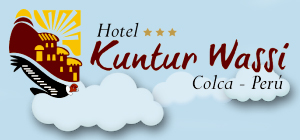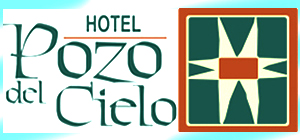PERU TOUR PACKAGES
- 4x4 Rental & Tours In Peru
- Private Ground Transportations In Peru
- DAY TRIP FROM CUSCO TO PUNO with stop at NEW Pallay Punchu Rainbow Mountain
- 2 DAYS PRIVATE SHUTTLE FROM CUZCO TO PUNO THOUGH MOUNTAINS
- Peru Self Driving Cars
- 4WD Exclusive Private Transfer From Arequipa To Puno
- Day Tour To Reserva De Salinas Y Aguada Blanca
- One Day Arequipa Off-Roading Tour
- Half Day Sandboarding Tour In Arequipa
- 3 Day Of Adventure Tours In Arequipa
- Full Day Sandboard Tour From Lima
- Lima Paracas Ballestas Ica Wineyards Huacachina Nazca Llines In 2 Days
- 6 DAYS COLCA CANYON ADVENTURE TOUR Rock Climbing - Biking - Horse Riding - Hiking & Camping
- Cusco Traditional Tour And Inti Raymi Festival
- Lima Cusco And Machu Picchu 3 Days
- Cusco Sacred Valley And 2 Days Inca Trail Trek To Machu Picchu
- Tour To Amazon Rainforest And Machu Picchu In 6 Days
- Cusco And Classic 4 Days Inca Trail Trek To Machu Picchu In 7 Days
- Jungle Tour - White Water Rafting And Lares Trek To Machupicchu - 14 Days
- Lima Amazon Jungle Cuzco And Machu Picchu Tour - 7 Days
- Tours to Nazca From Lima 2 Days
- Full Day Flight Nazca Lines From/to Pisco
- Lima Paracas Nasca Tour 3 Days
- Lima Cusco And Arequipa Tour 8 Days
- Full Day Nasca Lines By Luxury Public Bus
- Overflight Nazca Line From Lima By Aircraft Travel - Full Day Guided Tours
- Nasca Line From Lima By Land & Aircraft Travel - Full Day Guided Tours
- Daily Flights Over The Nazca Lines From Ica - Half Day Tour
- Sandboard And Sand Buggy In Peru 5 Days
- NEW Sandboarding Tour In Arequipa - Full Day Guided Excursion
- Cusco Complete Tour 5 Days
- Cusco And Puno Tour 7 Days
- Cuzco Colca Canyon Arequipa - 4WD Guided Tour 2 Days
- NEW 4X4 Expedition From Cuzco To Colca Valley And Arequipa 3 Days
- NEW Arequipa Colca Canyon Puno Guided Tour In 2 Days
- Arequipa And Puno Tour 6 Days
- 4x4 Tour Arequipa - Colca Canyon - Cusco 3 Days
- NEW Puno Colca Canyon Arequipa Guided Tour In 2 Days
- Peru Classic Tour 14 Days
- Peru Classic Tour And Inka Trail To Machu Picchu 14 Days
- Peru Luxury Tours 7 Days
- Peru Adventure Tour 24 Days
- Peru Jungle Tour
- Peru Bike Tours 14 Days
- Peru Mountain Biking 25 Days
- Peru Mountain Climbing
- Peru Off Road Tour
- Peru Royal Tour 8 Days
- Peru Trekking 25 Days
- Peru South Coast Tour 7 Days
- Peru Motorcycle Tour 21 Days
- Puno Colca Canyon And Arequipa Tour 3 Days
- Puno Colca Canyon Puno 2 Days
- Puno Colca Canyon Puno 3 Days
GENERAL INFORMATION ABOUT AYACUCHO
FAST FACT AND ORIENTATION OF AYACUCHO
Country: PeruRegion: Ayacucho ("Purple Soul" in the Quechua language)
Founded: In 1539 by Spanish
Location: Region of Ayacucho / Province of Huamanga
Status: City / provincial capital
Elevation: 2750 meters above sea level
Population: Approximately 150,000
Language: Spanish and Quechua
Local Currency: Peruvian Nuevo Sol (PEN)
Arrival: By daily bus service and airplanes
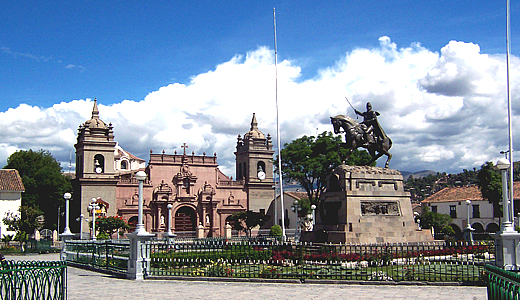
HISTORY OF AYACUCHO
Ayacucho was the center of the Wary culture, which emerged in the region around 700 AD and spread its powerful and evocative religious symbolism throughout most of Peru over the next three or four hundred years. After of the demise of the Wary, the ancient city later became a major Inca administrative center. The Spanish originally selected a different nearby site for the city at Huamanguilla but this was abandoned in 1540 in favour of the present location. Ayacucho’s strategic location, vitally important to both the Incas and the Spanish colonials, meant that the city grew very wealthy as miners and administrators decided to put down roots here, eventually sponsoring the exquisite and unique wealth of the city’s churches, which demonstrate the clearly high level of Masonic and woodworking skills of the local craftspeople.The bloody battle of Ayacucho, which took place near here on the Pampa de la Quinua on December 9th of 1824, finally released Peru from the shackles of Spain. The armies met early in December, when Viceroy José de la Serna attacked the Sucre’s republicans force in three columns. The pro-Spanish soldiers were, however, unable to hold off the republican forces who captured the viceroy with relative ease. Ayacucho was the last part of Peru to be liberated from colonial power.
Though quiet these days, Ayacucho was also radical university town with a leftwing traditions going back at least fifty years, known around the world for the civil war between terrorists and the Peruvian armed forces during the 1980s.
Most civilian in the region remember this era as one where they were trapped between two evils – the terrorists on the one hand and the retaliatory military on the other. A large proportion of villagers from remote settlements in the region consequently decide to leave the area, which they hoped would offer them relative safety. Despite efforts by Fujimori’s government to rehabilitate these communities and entice people back from Lima to their rural homes in the 1990s, many of them remain in the capital today.
Ayacucho sits in the Andes around 2800m high in one of Peru’s most archaeologically important valleys, which evidence such as ancient stone tools found in nearby caves at Pikimachay, which suggest that the region has been occupied for over 20,000 years. Its climate, despite the altitude, is pleasant all year round – dry and temperature with blue skies nearly every day – and temperatures average 16ºC (60ºF). The surrounding hills are covered with cacti, broom bushes and agave plants, adding a distinctive atmosphere to the city.
Ayacucho is a attractive colonial city, with splendid churches and mansions packed together in dense blocks around the central Plaza de Armas (also known as the Plaza Mayor) at those centre rests a monument to Mariscal José Sucre.
The 1540 Temple de San Cristobal, on block 7 of Jiron 28 de Julio was the first church built in Ayacucho; it has a single nave and only one altar, plus an unusual fine stone and adobe roof. But the Catedral, just off the Plaza Mayor, is of more interest. Built of red and grey stone between 1612 and 1671. It has a fine, three-aisled nave culminating in a stunning Baroque gold-leaf altarpiece. The Iglesia de Santo Domingo. Block 2 of Jiron 9 de Diciembre, was founded in 1548 and possesses one of the most beautiful exteriors in the city, with three arches of brick and lime, said to be where heretics were hangedand tortured during the Spanish Inquisition. Inside, the church houses a Baroque and Churrigueresque gold-leaf altar and two images – El Señor del Santo Sepulcro and the Virgen Dolorosa – Only brought ouf for the Easter processions. In block 1 of Jiron 28 de Julio is the Jesuit Templo de la Compañia, built in 1605 and renowned for its distinctive Churrigueresque style main altar. The Casona Jauregui, on block 2 of Jiron Dos de Mayo, is a lovely seventeenth-century mansion built by Don Cayetano Ruis de Ochon; it has a superb patio and balcony with two lion statues and a stone shield of Indian influence displaying a two-headed eagle. The Museo Pinacoteca de San Francisco de Asis, in block 3 of Jiron 28 de Julio, is known for its library of unique historical works, and there are a couple of art galleries in town: the Casona Vivanco, Jiron 28 de Julio, with a particularly good collection of colonial art, and the Galeria de Arte Popular.
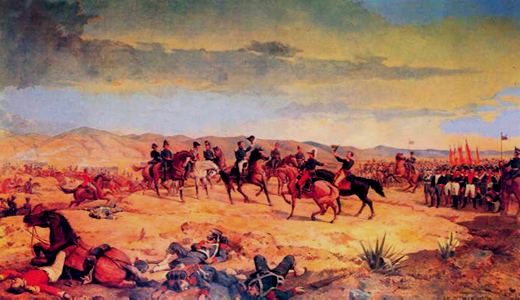
ARTS AND CRAFTS
Manu visitors come to Ayacucho’s thriving craft industry, mainly woven rugs and retablos (finely worked wooden boxes containing intricate three-dimensional religious scene made mainly from papier-mache).For fascinating insight into Inca and pre-Inca art and culture, a visit to Barrio Santa Ana is a must. Here more than 200 families have workshops making artesanias: textiles and retablo, ceramics and work in stone.
FESTIVALS AND EVENTS (Semana Santa)
Ayacucho's Semana Santa is the most important event in Peruvian religious calendar begins on the Friday before Palm Sunday and continues for 10 days until Easter Sunday. The Friday before Palm Sunday is market by a procession in honor of La Virgen de los Dolores or “Our Lady of Sorrows”, during which is customary to inflict “sorrows” on bystanders by firing pebbles out of slingshots.Each succeeding day is market with solemne yet colorful processions and religious rites, which reach a fever pitch of Catholic faith and tradition. They culminate on the Saturday before Easter Sunday with a huge all night party leading up to dawn fireworks to celebrate the resurrection of Christ.
In addition to the religious services, Ayacucho’s Semana Santa celebrations include numerous secular activities, art shows, folk dancing competitions and demonstrations, local music concerts, street events, sporting events (especially equestrian ones), agricultural fairs and also the preparation of traditional meals.
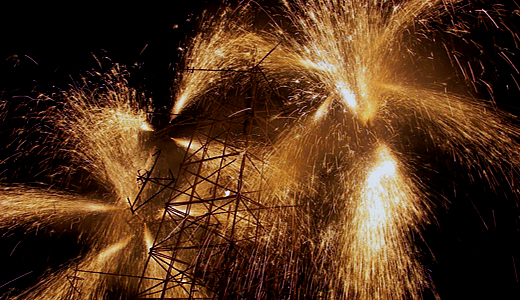
TOURIST ATTRACTION AROUND AYACUCHO
THE VALLEY OF LAURICOCHAThe valley of Lauricocha is located on the northeast and 5km away from Ayacucho and this is notable as the site of perhaps the oldest known culture in South America, 20,000 years old, evidence of which was found in the cave of Pikimachay. The cave is 24km from Ayacucho, on the road to Huanta. It is a 30 minutes walk from the road. The remains are now in Lima’s museums.
These early inhabitants are thought to have been nomadic hunters and gatherers. Remains of ancient chopping implements, basalt, and blades have been found, along with bones of a giant sloth. It was not until 4,000 BC that agriculture was introduced, and man started cultivating crops such as beans, squash, and chilies.
The valley of Lauricocha is much visited because has lovely warm climate and their famous platos tipicos (typical foods).
WARY OR HUARI CULT INFLUENCE
The city of Huari had a population of 50,000 and reached its apogee in AD 900. Its influence spread throughout much of Peru: north to Cajamarca; along the north coast to Lambayeque; south along the coast to Moquegua; and south across the Sierra to Cusco. Before the Inca invasion, the Huari formed a Chancas – a confederation of ethnic groups – amd populated the Pampas River and an area west of the Apurimac. This political agreement between the peoples of Ayacucho, Andahuaylas, Junin and Huancavelica was seen by the Incas in Cusco as a threat. The Incas fought back around 1440 with a bloody attack on the Huari on the Pampa de Ayacucho, and so began a period of Inca domination, the scene of this massacre is still known as Rincon de los Muertos.
THE HUARI COMPLEX
This is located 22km from Ayacucho, a good road going north from Ayacucho leads to Huari (frequently spelt Wari), dating from the “Middle Horizon” (AD 600-1000),when the Huari culture spread across most of Peru. This was the first urban walled centre in the Andes and was used for political, administrative, ceremonial, residential and productive purposes.
The huge irregular stone walls are up to 4m high and rectangular houses and streets an be making out. There are large areas of flat stone, which may have been for religious purposes, and there are tomb complexes and subterranean canals and tunnels.
The most important activity here was the artistic productions. High temperatures ovens were used the mass produce ceramics of many different colours. The Huari also worked with gold, silver, metals and alloys such as bronze, which was used for weapons and decorative odjects. The ruins now lie in a extensive tuna cactus forest.
There is a small museum at the site, but very little direction and the few explanations are only in Spanish. Tombs of the Huari nobles are being excavated along the road from Ayacucho to La Quinua valley.
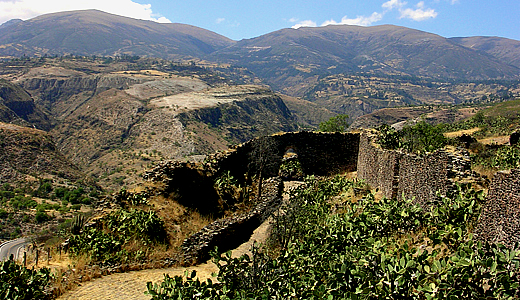
LA QUINUA
Valley de la Quinua is located 37km northeast of Ayacucho, has a charming cobbled main plaza and many of the buildings have been restored. There is a small market on Sundays. Nearby on the Pampa de la Quinua, a huge obelisk commemorates the battle of Ayacucho. The obelisk is 44m high, representing 44 years of struggle for independence.
The village’s handicrafts are recommended, especially ceramics, which range from model churches and nativity figures to humorous groups of musicians and gossiping women. The rich red local clay is modeled mainly by hand and decorated with local mineral earth colours. Traditionally, the model churches are set on the roofs of newly occupied houses to ward off evil spirits.
THE VALLEY OF HUANTA
The town of Huanta, one hour from Ayacucho on the road to Huancayo, overlooks the valley and has a pleasant plaza with palms and other trees. It was in Huanta that the Pokras and Chancas warriors put up their last, brave fight against the Inca invasion.
Huanta celebrates the Fiesta de la Cruz during the first week of May like everywhere in Peru, with much music and dancing around little chapel where decorated wood or iron cross is.
VILCASHUAMAN AND VISCHONGO
The impressive Inca ruins of Vilcashuaman are four hours to the south of Ayacucho (120km), beyond Cangallo. According to John Hemming, Vilcashuaman was an important provincial capital, the crossroads where the road from Cuzco to the Pacific Ocean met the empire’s north-south highway.
Near of Vilcashuaman is the village of Vischongo, which has a market on Wednesday. About an hour’s walk uphill from the village are the Inca baths of Intihuatana, which are worth seeing as much for their superb location on a beautiful lake as for the ruins themselves.
It is possible to see both ruins in a day guided tour, though it’s more relaxing to spend the night in Vilcashuaman, or better still, camp at the lake near Vischongo and Intihuatana.
THE SHINING PATH (Sendero Luminoso)It is in the central highlands of Peru, in the province of Ayacucho, that this fearsome revolutionary organization has its roots. Officially known as the Communist party of Peru, they adopted the snappier name of “Sendero Luminoso (Shining path) to distinguish themselves from the numerous other communist organizations in Peru. Founded in the late 1960s, the organization started by Abimael Guzmán (the founder) initially gained support among the poor farmers in the mountains around Ayacucho.The group’s platform was initially peaceful, but in 1980 the leaders met secretly in Ayacucho and declared was on the state. The Sendero acted as a peasant’s revenge force, torturing and killing cattle rustler’s unpopular farm managers and criminals – acts that increased their popularity among some sections of the rural population. As the Shining Path took over greater and greater areas of the countryside, the farmers who had initially supported them turned against their extremist ways. The group’s ideology prevented farmers selling their products at capitalist markets, and their ever more extreme tactics were regarded with horror. The organization also targeted individuals, not just government figures but also peasants and workers leaders, as they tried to win support though fear and intimidation. In areas like Ayacucho, the Peruvian government set up armed self-defence committees, whose members were essentially anyone willing to oppose the Shining Path. These self-defence groups, though also guilty of human-rights abuses, severely weakened the rebels, and the killer blow was the capture of the charismatic Guzman. With the leader is custody, the group soon fell apart, and attacks became less and less frequent. Eventually, the government started to take notice. In 1982, emergency powers were granted to the army in the Ayacucho region. Whole villages suspected of supporting the Shining Path were detained, and there were army sanctioned civilian massacres. For its part, the Shining was no less ruthless. One of the worst atrocities occurred in the upmarket Lima suburb of Miraflores killed 22 people and left buildings in ruins. The country has paid a bloody price. Almost 70.000 people died half at the hands of the Shining Path, with government forces and other groups responsible for the rest. Thankfully, Peru put its bloody and harrowing recent past behind it, and the central highlands, once the stronghold of the Marxists, is now a peaceful area where foreign visitors are welcomed by the friendly inquisitive locals. |
CONTACT US
For more information about the tour or you request a new date to departure for this tour, please contact us.... Some of our clients e-mail us saying our confirmation e-mails are placed to their spam folder rather than their inbox. We recommend to modify your JUNK or SPAM FILTER SETTINGS to receive our e-mails info(at)peruadventurestours.com or peruadventurestours(at)hotmail.com on the correct inbox. You may also want to add this email address to your list of known contacts. This will prevent our responses from being filtered into your Junk or Spam mail folder.
References Of Travel Guide Books To Peru
ADDITIONAL BOOKING SERVICES
- Camping Zone In Arequipa
- Bus Tickets All Over Peru
- Guided Tour Bus From Cusco To Puno
- Bus Transfer From Arequipa To Puno
- Bus Transfer From Colca Canyon To Puno
- Bus Transfer From Puno To Arequipa
- Airplane Tickets In Peru
- Railway Tickets In Peru
- Learn Spanish In Peru
- Rent A Car In Peru
- Rental Camping Gear In Peru
- Work In Peru
- Donation Program
PERU TRAVEL INFORMATION
- Embassies And Consulates In Peru
- Information Of South American Camelids
- Tips To Travel Around Peru
- Peru Adventure Magazine
- History Of The Incas And Tawantinsuyo Territory
- Inti Raymi Celebration In Cusco - The Festival Of The Sun God
- Travel Insurance To Peru
- Peruvian Government Taxes
- Travel Agent
PERUVIAN GASTRONOMY INFORMATION
- Peruvian Food
- History Of The Peruvian Cuisine
- Inca Cuisine
- Cuisine Of The Central Coast Of Peru
- Cuisine Of The Northen Coast Of Peru
- Cuisine Of The Andes Of Peru
- Cuisine Of Peruvian Jungle
- Art Culinary Of Arequipa
- Desserts And Sweets Dishes Of Peru
- Peruvian Recipes
- Peru Gastronomic Festivals
- Cultivation Of Ancient Plants Of Peru
- Coca Leaf





